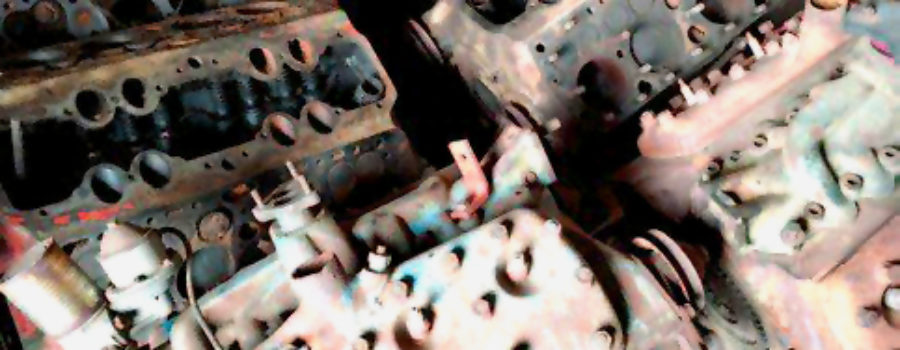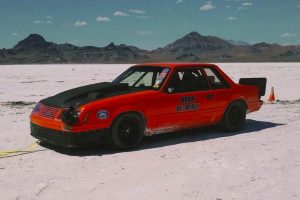The B.B. in the title represents that this is from the archive of the late Bill Bently, who ran a flathead Q&A informational site before he passed away. All threads from this source will be titled using the B.B. identifier on this site. We’re archiving some of the threads, so that his work is not lost or forgotten and so they will continue to educate flathead enthusiasts for years to come.
MY BELIEFS REGARDING DIFFERENCES IN 59 SERIES BLOCKS. Let me begin this by stating the following is what I’ve learned and believe from my association with flatheads. The 59 series blocks had better quality casting control than earlier blocks. This decreased the number of blocks with excessive core shifts. The following boring limitations are what I use for engines intended for the street. The 59 series blocks came in ‘46-’48 Ford and Merc’s. There aren’t any differences between Ford and Merc blocks during these years. All came with replaceable hard valve seats.
There were eight different engine designations to my limited knowledge: 59, 59A, 59AB, 59L, 59X, 59Y, 59Z, and 59ERP. The 59, 59A, and 59AB usually had no factory relief. These are the softest castings of the 59 series blocks. These will almost always bore to 3-3/8″ and still have adequate wall thickness left for street use. These were the most common blocks produced….. which is why they’re also the most common blocks still around today. The raised 59 number and letter (if used) are located on the top of the bell housing.The 59L was thought to be a Canadian truck/bus block, but many were delivered in US cars that came directly from USA factories. Many came with a factory relief and a 3-3/16″ bore. However, there are many around with the smaller 3-1/16″ bore. I’ve never tried boring one of these as a 3-3/16″ block (to 3-3/8″). I seriously doubt they can be bored this big since the walls would have to be SUPER thick to tolerate boring an additional 5/16″! (From rod nut 1/30/03: These 59L blocks with a 3-1/16″ bore can only be bore safely to 3-3/16″ +0.60″.)
There is a general belief 59L blocks have thicker walls than other blocks. But, after having seen several 59AB and a 59L blocks cut into sections, and after extensive measuring, I’m convinced all of the 59 series blocks with a 3-3/16″ bore were cast with the same cylinder wall thickness. The 59L blocks are harder than the 59, 59A, 59AB blocks with an accompanying increased resistance to cracking and wear. Due to their increased hardness, they will tolerate a bigger bore without cylinder wall flexing than the softer blocks.During the mid-fifties, I bored about a dozen of these to 3-7/16″ without any problem…. and this was long before sonic testing. The 59L is located on the top of the bell housing and is raised. Some of them have only a raised 59 number on top of the bell housing with either a raised, or stamped, L on the right side down near the right stay rod boss. These 59L blocks are now scarce, but can still be found if one is diligent and lucky. The 59Y block was thought to be for industrial applications only. But, like the 59L blocks, many are found in cars from both sides of the Canadian border. These usually came without a factory relief. Like the 59L blocks, a 3-7/16″ bore is possible. They are slightly harder than the 59L blocks and, hence, more desirable when building a full house engine or one that will be raced. These exhibit a greater resistance to cracking and wear than the 59L block. The raised 59Y code is located on the top of the bell housing. Some of them have the raised, or stamped, Y located on the right side near the stay rod boss. These 59Y blocks are quite scarce.The 59X and 59Z blocks were made for military use and came exclusively in military vehicles. Rumor has always held these were cast with more carbon, vanadium, and other hardening elements to meet the more stringent military specifications. I don’t know if that’s true, but I do know the ones I’ve seen were VERY hard. I stumbled across my first one in Texas in the early fifties at a wrecking yard. The machinist who bored it to 3-7/16″ said he would NEVER bore another one because it ate cutters like they were Snicker candy bars. They are the longest wearing 59 series block and are the blocks of choice. The few I’ve seen did not have factory reliefs. The 59X and 59Z have their raised 59 identification number located on top of the bell housing like most 59 series blocks.
All blocks I’ve seen had both the X and Z lettering stamped in the bell housing on the right side near the hole for the stay rod. These 59X and 59Z blocks usually bore to 3-7/16″ with no problems. Too bad they’re now almost impossible to find. The 59ERP block was made for the European market. The main bearing bores are 0.015″ oversize even though the crankshafts are standard Ford 3-3/4″ cranks…..they were line bored for thicker main bearings for some reason. These thicker bearings were stock Ford items at Ford agencies way back when. Today, one would probably end up making main bearings, or resort to using shim stock between the block and bearings.There is no physical difference externally between an ERP block and any other 59 block that I’ve ever found. Like the 59, 59A, and 59AB blocks, these are relatively soft blocks (they may be even softer). I’ve bored many of these to 3-5/16″ and still had plenty of wall thickness left. I’ve never bored one to 3-3/8″, but think they would take it. The 59ERP blocks I’ve been involved with did not have a factory relief.
The top of the bell housing has the normal raised 59-identification code. The ERP identification letters are ½”letters stamped in the pan gasket rail near the front of the block on the drivers side. The pan gasket covers the ERP stamping. These blocks are scarce.
Was this article a help? Consider supporting the Flat-Spot by becoming a Premium Member. Members get discounts with well known retailers, a cool membership packet full of goodies and your membership goes toward helping us upkeep and expand on this great archive.










